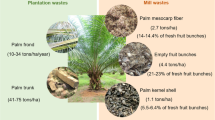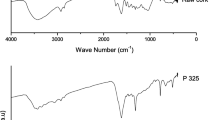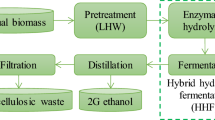Abstract
Plant biomass is a complex mixture formed mainly by cellulose, hemicellulose, and lignin, being of great importance as a source of renewable assets of great interest to industries, due to millions of tons/year of wastes produced and their great potential to yield a wide range of high added-value products. In this study, processes and physicochemical characterizations were developed for baru wastes (mesocarp and endocarp). This biomass was subjected to acid hydrolysis and slow pyrolysis steps in order to yield biobased products, among them bio-oil (> 28%) and biochar (> 48%). Analytical techniques such as mid-infrared spectroscopy and gas chromatography coupled to mass spectrometry, surface area and pore size, thermal analysis, and proximate and elemental analysis, helped in the elucidation, identification, and quantification of such compounds. Based on these results, it was possible to conclude that baru wastes have potential for application in several branches of industry, since compounds like vanillin (3.2%), syringol (9%), guaiacol (29%), creosol (22%), and palmitic (32%), and levulinic (4%) acids were found in significant amounts.

Bio-oil and biochar with high yields were obtained after the hydrolysis and pyrolysis processes.




Similar content being viewed by others
References
Ribeiro JF, Walter BMT (2008) As principais fitofisionomias do bioma cerrado. Cerrado: ecologia e flora, DF: Embrapa Informação Tecnológica, 151–212
IBGE – Instituto Brasileiro de Geografia e Estatística. (www.ibge.org.br/). Access: September/2018
Rambo MKD et al (2019) Sustainability of biorefinery processes based on Baru biomass waste. J Braz Chem Soc 56:1–7
Arni SA (2018) Comparison of slow and fast pyrolysis for converting biomas sinto fuel. Renew Energy 124:197–201
Hornung A (2014) Transformation of biomass: theory to practice. John Wiley & Sons, Chichester
Muradov N, Fidalgo B, Gujar AC, Garceau N, T-Raissi A (2012) Production and characterization of Lemna minor bio-char and its catalytic application for biogas reforming. Biomass Bioenergy 42:123–131
Giagnoni L, Maienza A, Baronti S, Vaccari FP (2019) Long-term soil biological fertility, volatile organic compounds and chemical properties in a vineyard soil after biochar amendment. Geoderma 344:127–136
Lee HW, Kim YM, Kim S, Ryu C (2018) Review of the use of activated biochar for energy and environemtal applications. Korea Sci 26:1–10
Xiu S, Shahbazi A (2012) Bio-oil production and upgrading research: a review. Renew Sust Energ Rev 16:4406–4414
Dai L, Wang Y, Yuhuan L, Roger R (2019) Comparative study on characteristics of the bio-oil from microwave-assisted pyrolysis of lignocellulose and triacylglycerol. Sci Total Environ 25:235–253
Melligan F et al (2012) Characterization of the products from pyrolysis of residues after acid hydrolysis of Miscanthus. Bioresour Technol 108:258–263
Rambo MKD, Aguiar NO, Novotny EH, Canelas LP, Auccaise R, Rambo MCD (2014) Pyrolysis of banana and coffee residues after acid hydrolysis. J Chem Chem Eng 8:960–970
NREL/TP-510-42618: Determination of structural carbohydrates and lignin in biomass. Biomass Analysis Technology Team Laboratory Analytical Procedure. National Renewable Energy Laboratory. https://www.nrel.gov/docs/gen/fy13/42618.pdf (2011). Accessed 05 Sep 2018
ASTM D 3173-87: Standard method for determination of moisture content in biomass, West Conshohocken, 2003
ASTM D 3174-04: Standard method for ash in the analysis sample of coal and coke, West Conshohocken, 2004
ASTM-D3176-15. Standard practice for ultimate analysis of coal and coke, West Conshohocken, 2015
NREL/TP-433-7965: An atlas of thermal data for biomass and other fuels. National Renewable Energy Laboratory. 1995
Essig M et al (1988) Research in thermochemical biomass conversion. Elsevier Apllied Science. 841-854
Zhou S, Runge TM (2014) Validation of lignocellulosic biomass carbohydrates determination via acid hydrolysis. Carbohydr Polym 112:179–185
Verheijen F, Jeffery S, Bastos AC, Velde M, Diafas I (2010) Biochar application to soils. A critical scientific review on soil properties, processes and functions. Euro Commission Office Off Publ Euro Commun 2:978–992
IBI - International Biochar Initiative. Standardized Product Definition and Product Testing Guidelines for Biochar That Is Used in Soil. Product Definition and Specification Standards. https://www.biochar-international.org/wp-content/uploads/2018/04/IBI_Biochar_Standards_V2.1_Final.pdf 2015. Accessed 8 Oct 2018
Nizamuddin S, Mubarak NM, Tiripathi M, Jayakumar NS, Sahu JN, Chintala G (2016) Chemical, dielectric and structural characterization of optimized hydrochar produced from hydrothermal carbonization of palm shell. Fuel. 163:88–97
Chintala R, Mollinedo J, Schumacher TE, Malo DD, Julson L (2014) Effect of biochar on chemical properties of acidic soil. Arch Agron Soil Sci 60:393–404
Li S, Chen G (2018) Thermogravimetric, thermochemical, and infrared spectral characterization of feedstocks and biochar derived at different pyrolysis temperatures. Waste Manag 78:198–207
Yu S, Jinje P, Minsu K, Changkook R (2019) Characterization of biochar and byproducts from slow pyrolysis of hinoki cypress. Food Agricult Organ UN 55:1533–1555
Costa PD, Furmanski LM, Dominguini L (2015) Produção, Caracterização e Aplicação de Carvão Ativado de Casca de Nozes para Adsorção de Azul de Metileno. Rev Virtual Quim 7:1272–1285
Garg S, Das P (2019) Microporous carbon from cashew nutshell pyrolytic biochar and its potential application as CO2 adsorbent. Biomass Conversion Biorefinery. https://doi.org/10.1007/s13399-019-00506-1
Martins et al (2019) Detoxification of fermentable broth with activated biocarbon resulting from pyrolysis of agro-forestry residues. Waste and Biomass Valorization, In press
Linhares FA, Marcilio NR, Melo PJ (2016) Estudo da produção de carvão ativado a partir do resíduo de casca da acácia negra com e sem ativação química. Scientiacum Industria 4:74–79
Lamber TW, Holmes CFB, Hrudey SE (1996) Adsorption of microcystin-LR by activated carbon and removal in full scale water treatment. Water Res 30:1411–1422
Zhongxin T, Shengnan Y (2019) The effect of preparing temperature and atmosphere on biochar’s quality for soil improving. Waste Biomass Valorization 10:1395–1405
Cardoso AL (2004) Pirólise Lenta de Serragem de Eucalipto para produção de bio-óleo e carvão. Dissertação mestrado em Química Analítica, 68 f
Mohammed M et al (2012) Gasification of oil palm empty fruit bunches: a characterization and kinetic study. Bioresour Technol 110:628–636
Asadieraghi M, Daud WMAW (2014) Characterization of lignocellulosic biomass thermal degradation and physiochemical structure: effects of demineralization by diverse acid solutions. Energy Convers Manag 82:71–82
Khalil HPSA et al (2001) Thermal, spectroscopic, and flexural properties of anhydride modified cultivated Acacia spp. Wood Sci Thecnol 45:597–606
Elias SL, Innis SM (2002) Bakery foods are the major dietary source of transfatty acids among pregmant women with diets providing 30 percent energy from fat. J Am Diet Assoc 102:46–56
Batista ES, Costa AG, Pinheiro HMS (2007) Adição da vitamina E aos alimentos: implicações para os alimentos e para a saúde humana. Rev Nutr 20:525–535
Oasmaa A, Peacocke C (2001) A guide to physical property characterisation of biomass–derived fast pyrolysis liquids. Technical Research Centre of Finland. https://www.vtt.fi/inf/pdf/publications/2001/P450.pdf
Author information
Authors and Affiliations
Corresponding author
Additional information
Publisher’s Note
Springer Nature remains neutral with regard to jurisdictional claims in published maps and institutional affiliations.
Statement of novelty
With the increasing demand for energy and the fast depletion of petroleum resources, there is a great interest in alternative and renewable residual biomasses. This includes lignocellulosic materials that are cheap and readily available, either in the form of agricultural waste or forest residues. However, physical and chemical characterization of this biomass is required for a correct destination and better use. In this study, several methods have been applied such as thermal analysis, proximate and ultimate analysis, infrared spectroscopy, calorific value, total extractives, total lignin, and theoretical yield of bioproducts in order to determine the physical and chemical composition of the Brazilian baru residues yielded in the hydrolysis and pyrolysis processes. All these properties showed that all baru biomasses are potential sources for biofuel and biochar production, therefore presenting a great biorefining potential.
Rights and permissions
About this article
Cite this article
Rambo, M.K.D., Nemet, Y.K.S., Júnior, C.C.S. et al. Comparative study of the products from the pyrolysis of raw and hydrolyzed baru wastes. Biomass Conv. Bioref. 11, 1943–1953 (2021). https://doi.org/10.1007/s13399-019-00585-0
Received:
Revised:
Accepted:
Published:
Issue Date:
DOI: https://doi.org/10.1007/s13399-019-00585-0




